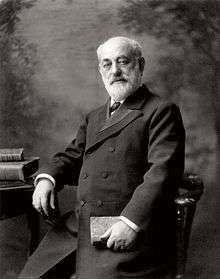Marcus Goldman
Marcus Goldman (December 9, 1821 – July 20, 1904) was a German investment banker, businessman, and financier. He was born in Trappstadt, Bavaria and immigrated to the United States in 1848.[1] He was the founder of Goldman Sachs, which has since become one of the world's largest investment banks.[2]
Marcus Goldman | |
|---|---|
 | |
| Born | Mark Goldman December 9, 1821 |
| Died | July 20, 1904 (aged 82) |
| Nationality | American Ashkenazi Jews |
| Occupation | Investment Banker, businessman, financier |
| Spouse(s) | Bertha (née Goldman; m. 185?) |
| Children | Julius Goldman Rebecca Dreyfuss (married to Ludwig Dreyfuss) Rosa Sachs (married to Julius Sachs) Louisa Sachs (married to Samuel Sachs) Henry Goldman (1857–1937) |
Early life
Marcus Goldman was born Mark Goldmann on December 9, 1821 in Trappstadt, Bavaria, Germany.[3][4] His father, Wolf Goldmann, was a farmer and cattle dealer.[3] His mother, Bella Katz Oberbrunner, who came from Zeil am Main, was widowed with five children from a former marriage; her first husband was called Samuel Oberbrunner.[3] His family was Ashkenazi Jewish. His paternal grandfather was called Jonathan Marx until he changed his name to Goldmann when Jews were allowed to have surnames in 1811.[3] While attending classes at the synagogue in Würzburg, he met Joseph Sachs, who would become his lifelong friend.[5]
Goldman immigrated to the United States from Frankfurt am Main, Germany, in 1848 during the first great wave of Jewish immigration to America, resulting from the Revolutions of 1848 in the German states. Upon arriving in America, his name was changed to Marcus Goldman by US immigration.[6]
Career
Goldman worked as a peddler with a horse-drawn cart and later as a shopkeeper in Philadelphia, where he initially rented the room in a boarding-house previously rented by his old friend Joseph Sachs.[6] In 1869, Goldman relocated to New York City and hung out a shingle on Pine Street in lower Manhattan, with the legend "Marcus Goldman & Co.", setting himself up as a broker of IOUs.
From his earliest days of his business, Goldman was able to singlehandedly transact as much as $5 million worth of commercial paper a year. Successful though he was, Goldman's business was insignificant compared to that of the other Jewish-German bankers of the day. Concerns like J. & W. Seligman & Co., with working capital of $6 million in 1869 (equivalent of $115 million in 2019), were already modern-day investment bankers immersed in underwriting and trading railroad bonds.
In 1882, Goldman invited his son-in-law Samuel to join him in the business and changed the firm's name to M. Goldman and Sachs. Business boomed—soon the new firm was turning over $30 million worth of paper a year—and the firm's capital was now $100,000 (equivalent of $2.6 million in 2019), all of it the senior partners'.
For almost fifty years after its inception, all of Goldman Sachs's partners were members of intermarried families. In 1885, Goldman took his own son Henry and his son-in-law Ludwig Dreyfuss into the business as junior partners and the firm adopted its present name, Goldman Sachs & Co. In 1894, Henry Sachs entered the firm, and in 1896, the firm joined the New York Stock Exchange.
When Goldman retired, he left the firm in the hands of his son Henry Goldman and his son-in-law Samuel Sachs. In 1904, two of Sachs' sons, Arthur and Paul, joined the firm immediately after graduating from Harvard University.
Personal life and death
Goldman married eighteen-year-old Bertha Goldman, who had also immigrated from Germany. They had five children. Goldman's youngest daughter, Louisa, married Samuel Sachs, the son of close friends and fellow Lower Franconia, Bavaria immigrants.[1] Louisa's older sister and Sam's older brother had already married. His older son, Julius Goldman, married Sarah Adler, daughter of Samuel Adler.[7]
Goldman died in Elberon, New Jersey, in the summer of 1904.[8]
See also
References
- Kappner, Cordula (2008-03-12). "Marcus Goldmann und der amerikanische Traum". Mainpost (in German).
- Andrew Beattie (May 21, 2010). "The Evolution Of Goldman Sachs". Forbes.
- Breton Fisher, June (2010). When Money Was in Fashion: Henry Goldman, Goldman Sachs and the Founding of Wall Street. New York: Palgrave Macmillan. pp. 7–8. ISBN 9780230617506. OCLC 562769185.
- Marcus Goldmann und der amerikanische Traum, by Cordula Kappner, 12. März 2008 , mainpost.de (in German)
- Caplan, Sheri J. "Marcus Goldman." In Immigrant Entrepreneurship: German-American Business Biographies, 1720 to the Present, vol. 2, edited by William J. Hausman. German Historical Institute. Last modified May 07, 2015.
- Breton Fisher, June (2010). When Money Was in Fashion: Henry Goldman, Goldman Sachs and the Founding of Wall Street. New York: Palgrave Macmillan. pp. 17–18. ISBN 9780230617506. OCLC 562769185.
- Cohen, Getzel M.; Joukowsky, Martha Sharp (2006). Breaking Ground: Pioneering Women Archaeologists. University of Michigan Press. p. 299. ISBN 0472031740.
- "Obituary Notes: Marcus Goldman". The New York Times. July 21, 1904. p. 7. Retrieved August 24, 2016 – via Newspapers.com.

Further reading
- Birmingham, Stephen (1996). Our Crowd: The Great Jewish Families of New York. Syracuse University Press. ISBN 0815604114.
- Supple, Barry E. (1957). "A Business Elite: German-Jewish Financiers in Nineteenth-Century New York". Business History Review. 31 (2): 143–178. JSTOR 3111848.
External links
| Business positions | ||
|---|---|---|
| Preceded by Founder |
Chairman and CEO, Goldman Sachs 1869–1894 |
Succeeded by Samuel Sachs |